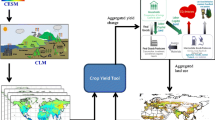Abstract
The Agriculture and Land Use (AgLU) model is a top-downeconomic model with just enough structure to simulate globalland-use change and the resulting carbon emissions over one century.These simulations are done with and without a carbon policy representedby a positive carbon price. Increases in the carbon price createincentives for production of commercial biomass that affect thedistribution of other land types and, therefore, carbon emissionsfrom land-use change. Commercial biomass provides a link betweenthe agricultural and energy systems. The Integrated Assessmentof Climate Protection Strategies (ICLIPS) core model uses AgLUto provide estimates of carbon emissions from land-use changeas one component of total greenhouse gas emissions. Each majorland-use type is assigned an average carbon density used to calculatea total carbon stock; carbon emissions from land-use change arecalculated as the change in carbon stock between time periods.Significant carbon emissions from land-use change are presenteven in the reference scenario. An aggressive ICLIPS mitigationscenario results in carbon emissions from land-use change upto 800 million metric tons per year above the AgLU referencescenario.
Similar content being viewed by others
References
Adams, D. M., Alig, R. J., Callaway, J. M., McCarl, B. A., and Winnett, S. M.: 1996, The Forest and Agricultural Sector Model (FASOM): Model Structure and Policy Applications, Research Paper PNW-RP-495, Forest Service, United States Department of Agriculture, Pacific Northwest Research Station, Portland, OR.
Alcamo, J., Kreileman, E., Krol, M., Leemans, R., Bollen, J., van Minnen, J., Schaeffer, M., Toet, S., and de Vries, B.: 1998, ‘Global Modeling of Environmental Change: An Overview of IMAGE 2.1’, in Alcamo, Leemans, Kreileman (eds.), Global Change Scenarios of the 21st Century: Results from the IMAGE 2.1 Model, Elsevier Science, Oxford, U.K.
Amemiya, T.: 1985, Advanced Econometrics, Harvard University Press, Cambridge, MA.
Bury, K.: 1999, Statistical Distributions in Engineering, Cambridge University Press, New York, NY.
Clarke, J. F. and Edmonds, J. A.: 1993, ‘Modelling Energy Technologies in a Competitive Market’, Energy Economics 15 (2), 123–129.
Darwin, R., Tsigas, M., Lewandrowski, J., and Raneses, A.: 1995, World Agriculture and Climate Change: Economic Adaptations, Agriculture Economic Report 703, United States Department of Agriculture, Washington, D.C.
Edmonds, J. and Reilly, J. M.: 1985, Global Energy: Assessing the Future, Oxford University Press, New York, NY.
Edmonds, J. A., Wise, M. A., Sands, R. D., Brown, R. A., and Kheshgi, H.: 1996, Agriculture, Land Use, and Commercial Biomass Energy, PNNL-SA-27726, Pacific Northwest National Laboratory, Richland, WA.
FAO (Food and Agriculture Organization of the United Nations): 2000, FAOSTAT data base, http://apps.fao.org.
Fischer, G., Frohberg, K. K., Keyzer, M. A., and Parikh, K. S.: 1988, Linked National Models: A Tool for International Food Policy Analysis, Kluwer Academic Publishers, Dordrecht, The Netherlands.
Goldemberg, J., Monaco, L. C., and Macedo, I. C.: 1993, ‘The Brazilian Fuel-Alcohol Program’, in Johansson, T. B., Kelly, H., Reddy, A. K. N., and Williams, R. H. (eds.), Renewable Energy: Sources for Fuels and Electricity, Island Press, Washington, D.C.
Lambin, E. F., Turner, B. L., Geist, H. J., Agbola, S. B., Angelsen, A., Bruce, J. W., Coomes, O. T., Dirzo, R., Fischer, G., Folke, C., George, P. S., Homewood, K., Imbernon, J., Leemans, R., Li, X., Moran, E. F., Mortimore, M., Ramakrishnan, P. S., Richards, J. F., Skånes, H., Steffen, W., Stone, G. D., Svedin, U., Veldkamp, T. A., Vogel, C., and Xu, J.: 2001, ‘The Causes of Land-Use and Land-Cover Change: Moving beyond the Myths’, Global Environ. Change 11 (4), 261–269.
Leemans, R., van Amstel, A., Battjes, C., Kreileman, E., and Toet, S.: 1996, ‘The Land Cover and Carbon Cycle Consequences of Large-Scale Utilization of Biomass as an Energy Source’, Global Environ. Change 6 (4), 335–357.
Leimbach, M. and Toth, F. L.: 2003, ‘Economic Development and Emission Control over the Long Term: The ICLIPS Aggregated Economic Model’, Clim. Change, this issue.
Toth, F. L., Bruckner, T., Fuessel, H.-M., Leimbach, M., and Petschel-Held, G.: 2003, ‘Integrated Assessment of Long-Term Climate Policies: Part 1-Model Presentation’, Clim. Change, this issue.
WRI (World Resources Institute): 1992, World Resources 1992-1993, Oxford University Press, New York, NY.
Wyman, C. E., Bain, R. L., Hinman, N. D., and Stevens, D. J.: 1993, ‘Ethanol and Methanol from Cellulosic Biomass’, in Johansson, T. B., Kelly, H., Reddy, A. K. N., and Williams, R. H. (eds.), Renewable Energy: Sources for Fuels and Electricity, Island Press, Washington, D.C.
Author information
Authors and Affiliations
Rights and permissions
About this article
Cite this article
Sands, R.D., Leimbach, M. Modeling Agriculture and Land Use in an Integrated Assessment Framework. Climatic Change 56, 185–210 (2003). https://doi.org/10.1023/A:1021344614845
Issue Date:
DOI: https://doi.org/10.1023/A:1021344614845




